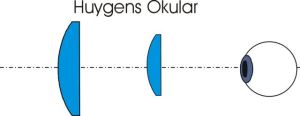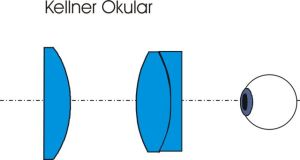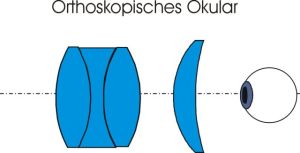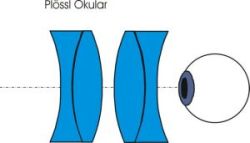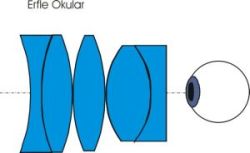Eyepieces
|
There are a flood of eyepieces of various designs on the amateur astronomical supply market which you can use for your own observing. You will hear strange-sounding names, terms such as field of view, focal length, exit pupil and then still not really know which eyepiece is it the right one for your observing. In order to remedy this somewhat, I have listed the various designs with their advantages and disadvantages below.
Huygens eyepiecesThese eyepieces are a simple two lens element design which provides a relatively small apparent field of view. The lenses are not cemented together and therefore well suited for solar projection through a telescope. These eyepieces are among the oldest designs and are only rarely found among telescopes accessories. Their field of view is about 40°.
Kellner eyepiecesKellner eyepieces are composed of three lens elements and have a field of view of around 45°. Since the two eye lenses are cemented and constitute an achromatic doublet, only a little chromatic aberration is produced. Kellner eyepieces can be used for higher magnifications with telescopes having an aperture ratio of up to 1:10. The limit with Newtonian reflectors is at an aperture ratio of 1:5, and here it is better to resort to Ploessl eyepieces.
Orthoscopic eyepiecesThese eyepieces have four lens elements, two of which are biconvex and one is biconcave. These eyepieces provide a high level of sharpness both at the centre as well as at the edge of the field of view. They are therefore also of interest for planetary and double star observing. They feature a flat image field. The low absorption exhibited by these lenses due to their use of only a few lens elements and accordingly good lens coatings is another plus for these eyepieces. Their field of view is about 40° to 45°.
Ploessl eyepiecesPloessl eyepieces are the astronomical standard lens and anyone who does not want to spend a lot can afford these eyepieces. Often one finds these Ploessl design lenses in complete accessories kits for beginners.
Super Plossl eyepieces examples of 52 ° field of view. ErfleYou cannot find Erfle eyepieces in modern accessory catalogues as this type is no longer directly available. However, many eyepieces can be found among astronomical accessories that have the basic features of this design. Many modern eyepieces are actually a development of the Erfle design.
Long eye relief eyepiecesThese eyepieces have become especially popular in recent years. If you look at the eyepieces used by any amateur astronomer, you will probably find at least one of this type. These eyepieces cannot be assigned to any one particular design, but rather have long eye relief as a dominant feature. Ultra Wide Angle eyepieces example
NaglerNagler eyepieces are an in-house development from the eyepiece manufacturer TeleVue. The main elements of these eyepieces consist of a number cemented doublets. Most of these eyepieces have seven lens elements, but there are also variations using fewer elements. These eyepieces you provide one with a fantastic impression of the night sky. They almost make you feel as if you are floating in space. This is due largely to their enormous apparent field of view of 80°.
2 inch eyepiecesAre you perhaps currently thinking of buying a telescope? Then you should also consider one with a 2" focuser, as this could give you a completely new perspective on the night sky. Or does perhaps your telescope already have a 2" focuser?
Field of viewThe field of view which can be achieved with an eyepiece is a crucial factor. If you look at the eyepieces available today, you will find fields of view ranging from 45° to 110°. Here, this means the ‘apparent field of view’ (AFOV) of the eyepiece - that is the angle that can be seen by means of the eyepiece. But these large fields of view can be misleading. This is because the AFOV is very far from the field of view that you can actually see in the sky. A very important criterion here is the telescope used. Different actual or true fields of view (TFOV) will be achieved, depending on the magnification used. If you know the AFOV of the eyepiece, then you can relatively easily calculate TFOV in the sky. The magnification of the eyepiece in the telescope: Example: You use a telescope with a 1000mm focal length and a 10mm eyepiece. 1000mm/10mm = 100X magnification Calculation of the true field of view (TFOV): As an example we take a Super Ploessl eyepiece with 52° AFOV: The field of view in the sky now has a size of 0.5° or *30 arc-minutes. For comparison, here is a table with the different fields of view:
How do you calculate the AFOV of an eyepiece if it is not provided? Measure the diameter of the field stop at the bottom of the eyepiece. To do this, unscrew the eyepiece barrel, allowing you to easily determine the diameter of the free passage of light. The second value you need is the focal length, which can be found printed on the eyepiece. The following inverse tangent function allows you to calculate the AFOV: AFOV = half the field stop diameter / eyepiece focal length tan-1 Not the whole field stop, but only half is used. Example: 6mm/12.5mm tan-1 = 25.6 x 2 = 51°
Spoilt for choice, which eyepiece suits my telescope?
|

